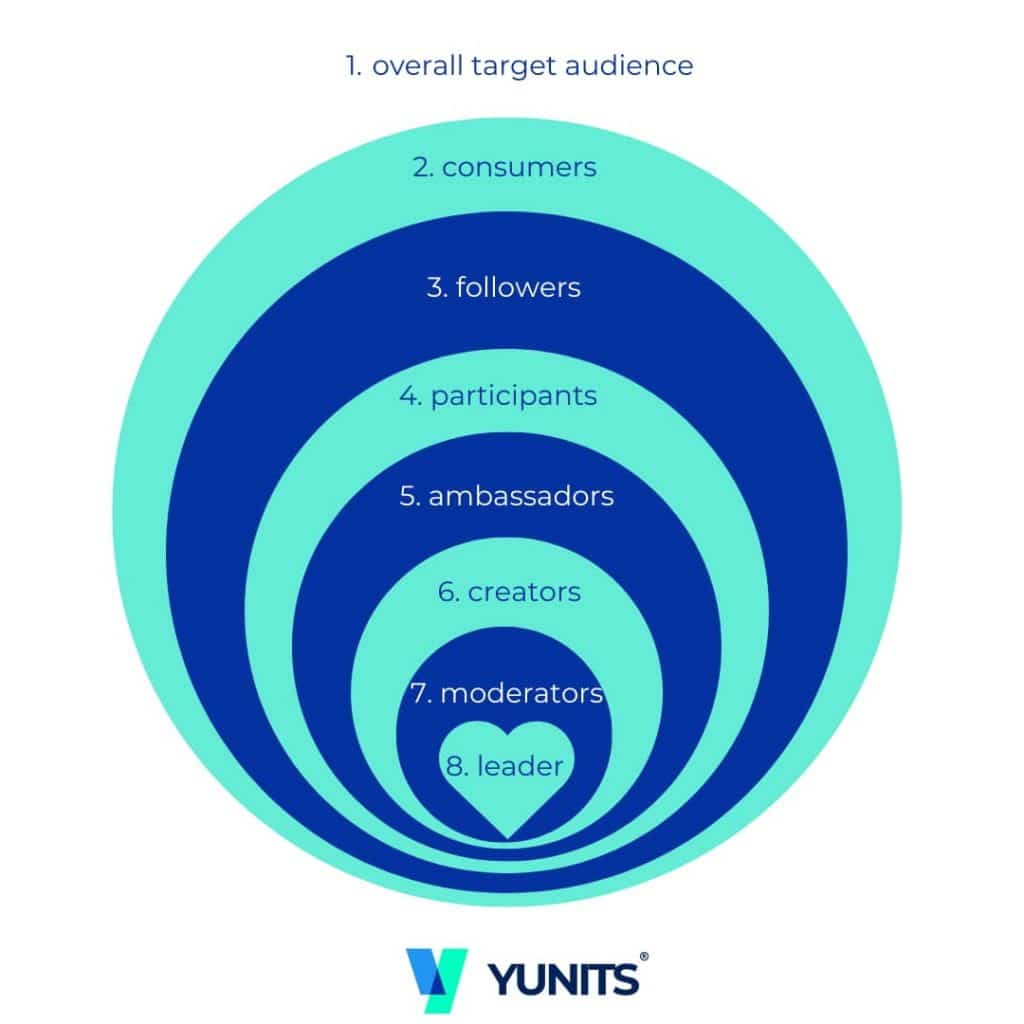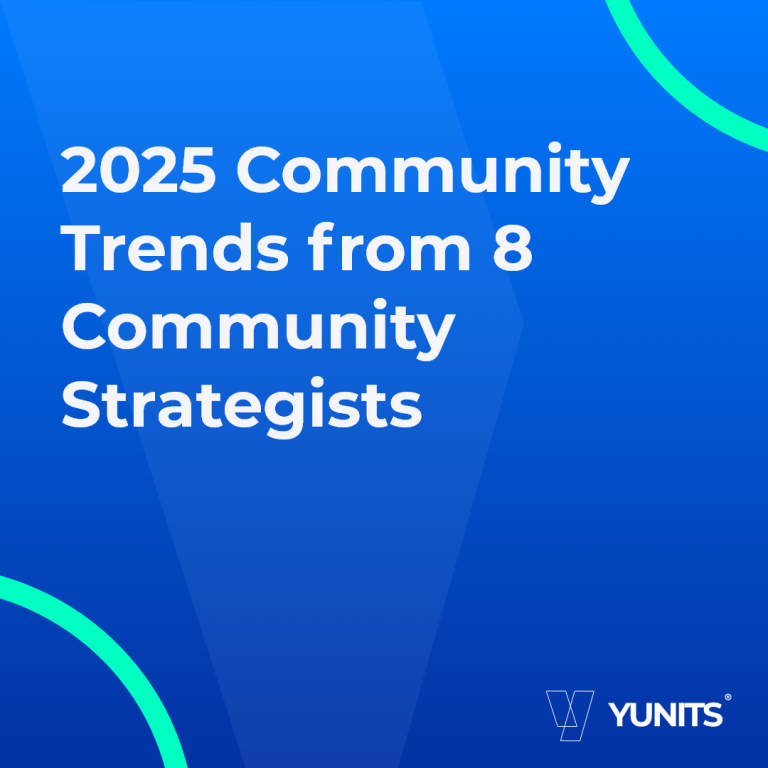The different types of community members
A community gives your target audience the opportunity to share their views on a particular topic, ask each other questions and exchange knowledge.
A community is dependent on its members. You do it for them and they make your platform what it is. The members help you keep the community alive and in some cases act as ambassadors for your community.
To have and build an influential community, you need to have an understanding of the different types of community members and how each type contributes to the community. After all, they are groups of people with their own needs, personalities and aspirations.
What types of members are there and how do you draw them in?
We differentiate eight types of community members, which are depicted in the circle chart below. Most people are represented by the outer tier, but these individuals are the least proactive. The individuals in the inner tier are few but very involved. These members are the heart of your community and are indispensable for a successful, growing community. But each type has its own attributes, which are all needed to build your community.

Tier 1: Overall target audience
Tier 1 is not yet part of your community. But we mention them because this group consists of your potential members. However, they are not yet acquainted with your community or have never been to your platform.
So, you need a new way to reach and draw these individuals to your platform. After all, the inception and growth of your community consist of individuals in this tier.
Tier 2: Consumers
These visitors are not yet members of your community, but they consume content. That is, they read posts on your platform, but they do not respond or contribute. They are not subscribed to your platform and so you do not know who they are. This tier only exists for communities with (partially) public content.
These individuals are nevertheless important to your organisation. After all, they generate traffic to your website and are interested in what you write, which is why they keep coming back.
Consumers may eventually become active on your platform. But even if they choose not to, they can bring your platform to the attention of others.
Tier 3: Followers
Followers are visitors who are members of your community. They, for example, read and have signed up for your newsletter or have turned on notifications to stay updated. They usually do not leave comments, but do actively follow what happens on your platform.
Moreover, they have registered so you possess their details. You could contact them for specific purposes.
Often, these are new members who do not want to react immediately. They will become more active and help build the community only when they feel comfortable. So, it is important that new members are made to feel welcome and safe on your platform.
Also read: How do you get your online community to engage?
Tier 4: Participants
Participants are active members of your community. They comment, ask questions and like other people’s posts. If you organise events, these are the people who attend. They are the familiar faces of the community and they follow everything related to it. They are the heart of your online community and make sure there is always something happening.
To make as many members a participant as possible, you need to invest a lot of time and encourage engagement. You also need to ensure that members in the outer tiers feel safe and connected to become participants too.
Also read: 12 tips to encourage activity in an online community
Tier 5: Ambassadors
Ambassadors are enthusiastic members of your community, who also spread the word. For a healthy community, you constantly need new users. After all, there are always members who drop out and you want to replace them. The best way to get new members is through word-of-mouth by current members, such as ambassadors.
They do this in personal conversations with their colleagues, but also by sharing information from your community with their network. This way, they make people who belong to your target audience enthusiastic and can convince them to join your community too.
This is the most powerful advertisement you can have for your community because if a close acquaintance is enthusiastic about something, you yourself will also be more inclined to try it.
Tier 6: Creators
Creators are incredibly important for your community. After all, they not only respond to existing content, but they also create new content for your platform, so you and your colleagues have less work trying to encourage others to create content.
These community members are so involved with your platform that they organise events or suggest new topics. Content created by members is very valuable for your platform. It inspires others to do the same.
Tier 7: Moderators
With a large community, it may pay to split it into smaller collaborative groups to keep it interesting for all members. Your most loyal and enthusiastic members can help you manage it. You can make them co-owners or moderators of (part of) the community. This will give your most loyal members responsibility and make them feel even more connected with your community. And it will ensure that your community regulates itself. This will help you cope with the growth of your platform.
As a community owner, it can be difficult to give members more ownership because it may seem like you have to relinquish some of your control. Yet member engagement is necessary and it makes your community mature.
Tier 8: Leader
Every group or community needs one or more people who take on a leadership role. These people listen to members and act when appropriate. Usually, this is the community manager or other people employed by your organisation, but you can also recruit leaders within the community.
Do make sure leaders act in the interests of the members. After all, a community only exists by the grace of its members and they need to feel at ease. This works best if leaders act informally and intervene only when absolutely necessary.
Which members are most important?
A community works at its best when all types of community members are present. After all, everyone has their role to play. Therefore, the biggest mistake you can make is to only listen to your active members, creators and leaders. That can cause consumers and followers to feel unwelcome and stop them from getting more involved and becoming active members too.
Gaining new members is important not only for expanding your community but also for preserving it. After all, there will always be loyal members who drop out for whatever reason. If you fail to replace them with new members, the community is doomed.
So, it is important to get as many people as possible involved in your community and give them opportunities to interact with you and with other members. This increases engagement and your community becomes more and more robust.
Need help setting up your online community?
Our team is ready to assist you in providing your members with an appealing online community. Our community software offers many components to support you in this, allowing you to get started relatively quickly. Our team will gladly support you every step of the way and help you define your community’s goal and strategy. Feel free to contact us.
Also read: 12 tips to encourage activity in an online community
Also read

Why choose a Yunits community platform over Microsoft Teams?

2025 Community Trends from 8 Community Strategists

